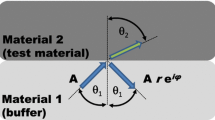Abstract
This paper reviews several existing, as well as potential, stress-wave-generating techniques for concrete. The generating techniques under study include standard ultrasonic pulse generators, high-energy ultrasonic toneburst systems, and simple impact. In addition, the use of laser sources and ultrasonic lithotripters are proposed. The novelty of this review is that the methods are analyzed considering applications to existing concrete NDE methods. The strengths and weaknesses of each generation technique are discussed. Some of the methods are demonstrated through laboratory tests on a variety of specimen types. A description of each technique and conclusions concerning the appropriateness of each technique are also made.
Similar content being viewed by others
References
Pessiki, S.P. and Carino, N.J., “Setting Time and Strength of Concrete Using the Impact-Echo Method,” ACI Mat. J.,85 (5), (Sept.–Oct. 1988).
Sansalone, M. andCarino, N.J., “Laboratory and Field Studies of the Impact-Echo Method for Flaw Detection in Concrete,”SP-112, ed. H.S. Lew, American Concrete Inst., Detroit, 1–20 (1988).
Carino, N.J. andSansalone, M., “Impact-Echo: A New Method for Inspecting Construction Materials,”NDT and NDE for Manufacturing and Construction, ed. H.L.M. dos Reis, Hemisphere Publishing Corp., New York, 209–223 (1990).
Carino, N.J. andSansalone, M., “Detection of Voids in Grouted Ducts Using the Impact-Echo Method,”ACI Mat. J.,89 (3),296–303 (May–June,1992).
Lin, Y. andSansalone, M., “Detecting Flaws in Concrete Beams and Columns,”ACI Mat. J.,89 (4),394–405 (July–Aug. 1992).
Heisey, J.S., Stokoe II, K.H., andMeyer, A.H., “Moduli of Pavement Systems from Spectral Analysis of Surface Waves,”Transporation Res. Record 852, TRB, Nat. Res. Council, Washington, D.C., 22–31 (1982).
Jones, R., “Surface Wave Technique for Measuring the Elastic Properties and Thickness of Roads: Theoretical Development,”Brit. J. Appl. Phys.,13 21–29 (1962).
Nazarian, S., Stokoe II, K.H., andHudson, W.R., “Use of Spectral Analysis of Surface Waves Method for Determination of Moduli and Thicknesses of Pavement Systems,”Transportation Res. Record 930, TRB, Nat. Res. Council, Washington, D.C., 38–45 (1983).
Rix, G.J., andStokoe II, K.H., “Stiffness Profiling of Pavement Subgrades,”Transportation Res. Record 1235, TRB, Nat. Res. Council, Washington, D.C., 1–9 (1990).
Nazarian, S. andStokoe II, K.H., “Nondestructive Testing of Pavements Using Surface Waves,”Transporation Res. Record 993, TRB, Nat. Res. Council, Washington, D.C., 67–79 (1984).
Nazarian, S. andStokoe II, K.H., “Use of Surface Waves in Pavement Evaluation,”Transportation Res. Record 1070, TRB, Nat. Res. Council, Washington, D.C., 132–144 (1986).
We-Du, L., “Frequency Spectrum: Analysis of Ultrasonic Testing Signal in Concrete,”Nondestructive Testing of Concrete Elements and Structures, ed. F. Ansari andS. Sture, Amer. Soc. Civil Eng., New York, 104–114 (1992).
Suaris, W. andFernando, V., “Ultrasonic Pulse Attenuation as a Measure of Damage Growth During Cycling Loading of Concrete,”ACI Mat. J.,84 (3),185–193 (May–June,1987).
Alexander, A.M. andThornton, H.T., “Developments in Ultrasonic Pitch-Catch and Pulse-Echo for Measurements in Concrete,”Nondestructive Testing, ACI SP-112, ed. H.S. Lew, American Concrete Inst., Detroit, 21–40 (1988).
Popovics, J.S. andRose, J.L., “A New Approach for the Analysis of Impact-Echo Data,”Review of Progress in Quantitative NDE,12B,Plenum Press,New York,2223–2230 (1993).
ASTM, Annual Book of ASTM Standards, Volume 4.02: Concrete and Aggregates, Philadelphia, 291–293 (1990).
Carleton, H.R. and Muratore, J.F., “Ultrasonic Evaluation of Concrete,” Proc. IEEE Ultrasonics Symp., 1017–1020 (1986).
Sansalone, M., and Carino, N.J., “Impact-Echo: A Method for Flaw Detection in Concrete Using Transient Stress Waves,” Rep. # NBSIR 86-3452, U.S. Dept. of Commerce (Sept. 1986).
Silk, M.G., Ultrasonic Transducers for Nondestructive Testing, Adam Hilger Ltd., Bristol, 120–135 (1984).
Tasker, C.G., Milne, J.M., and Smith, R.L., “Recent Work at the National NDT Centre on Concrete Inspection,” Proc. 28th Annual Brit. Conf. on Nondestructive Testing, Sheffield, UK, 271–284 (Sept. 1989).
Church, C.C., “A Theoretical Study of Cavitation Generated by an Extracorporeal Shock Wave Lithotripter,” J. Acoustical Soc. of Amer.,86 (1), (July 1989).
Reichenberger, H., “Lithotripter Systems,” Proc. IEEE,76 (9), (1988).
Author information
Authors and Affiliations
Rights and permissions
About this article
Cite this article
Popovics, J.S., Rose, J.L., Popovics, S. et al. Approaches for the generation of stress waves in concrete. Experimental Mechanics 35, 36–41 (1995). https://doi.org/10.1007/BF02325832
Received:
Revised:
Issue Date:
DOI: https://doi.org/10.1007/BF02325832




